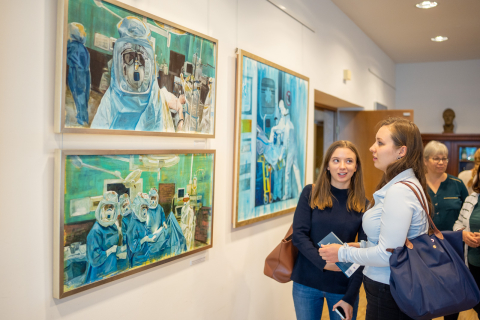Wanda Piskorska lives and creates in Gdańsk. She also graduated from the Academy of Fine Arts there. The artist became famous for her work on the film "Your Vincent" about the last days of Vincent van Gogh's life. It was the first full-length production in painterly animation, and the film received an Oscar nomination.
In the exhibition at the Museum of the History of Medicine, we can see a series of seven works by the painter entitled "Image of the Days." They depict the struggle for human life and health during the COVID-19 pandemic. And most of the presented scenes actually took place in the Covid Hospital in Gdansk.
- Wanda Piskorska's paintings are an acknowledgment to doctors for their heroic efforts during the pandemic. Our exhibition is also an expression of this - Grażyna Jermakowicz, director of the Museum of the History of Medicine MUW and organizer of the event, said at the opening. She also expressed the hope that the exhibition will be the opening for a new series of museum events concerning the area of culture and art, and that the Museum of the History of Medicine will become a place to exhibit creativity in general and the work of the medical community.
The exhibition was officially opened by Professor Zbigniew Gaciong, Rector of MUW. - It is said that medicine is an art, which is not entirely true, because the element of craftsmanship is very important and should not be forgotten. However, here we have the opposite situation. We have medicine in art - said the Rector.
Also present at the vernissage were Prof. Paweł Włodarski, Vice Rector for International Relations, Development and Promotion, and Ernest Kuchar, MD, PhD, from the Department of Pediatrics with Clinical Assessment Unit, a specialist in infectious diseases, as well as many students and employees of MUW.
Ernest Kuchar, MD, PhD, recalled what a shock the outbreak of the pandemic was for us: - We, people born after the war, lived in blissful ignorance and complacency. We felt safe. And suddenly, after a century (because the last pandemic - the Spanish flu pandemic took place in 1918/19) the plague hit us. And it shook us off the complacency in which we persisted. For us doctors, the pandemic was also a personality test. I'll admit that I haven't experienced such emotions as I did back then. Many of us have never experienced such stress in our lives, never faced such difficult choices - the infectious disease doctor stressed. He also cited statistics. - Since the beginning of the COVID-19 pandemic, 630 million people have fallen ill worldwide, more than 6 million have died. In Poland, we are talking about more than 6 million sick and 117,000 dead. Yesterday, 31 people died from COVID-19. We are already used to this. This number of 31 deaths impresses no one today. Our generation will give way to the next one, which I hope will already be living in safe times and will not remember that our lives are not at all as safe as they seem. It is good that there are works of art to remind us of this. I hope that these paintings will remain as a testimony - concluded Ernest Kuchar, MD, PhD.
And where did the idea for such a series of paintings come from? Here is how Wanda Piskorska told about it: - It was the beginning of 2021. Lock down, the number of diseases was increasing all the time. We lived in isolation and at the same time we were surrounded by information and very many hospital images related to the pandemic. These images were very oppressive and difficult. I myself at one point wanted to run away from them. These frames, photographs, and films depicted a sense of loneliness, isolation, and being cut off from the world. This was further compounded by the costumes of the medical staff. I realized what a trauma we as a society would have to deal with. And then came the idea for paintings that would help us look at the pandemic differently and tame these oppressive frames. On the one hand, I wanted my works to be fairly realistic. But on the other hand, I wanted to translate the hospital images into a painterly language that adds nobility. Then you can look at them a little differently, perhaps more symbolically, from a distance. To give them a new meaning, a new dimension. This was my idea, you will judge whether I succeeded - said the painter, inviting to the exhibition.
